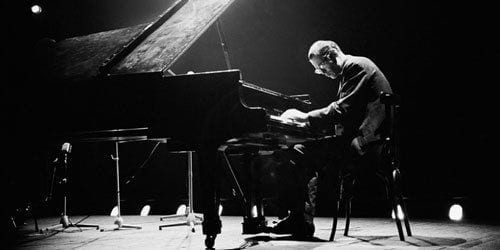
With the glut of live jazz recordings that get pushed on us — official and otherwise — it’s easy to get skeptical about new concert albums. Sets of questionable fidelity get patched together and thrown out to the jazz crowd and, all too often, these sets can be disappointing even if they are rare or the sets are full of obscure tunes or whatever other minor detail peaks our curiousity. When you’re dealing with someone like Bill Evans, who has two classic live records — Sunday at the Village Vanguard and Waltz for Debby — it’s even harder to believe that a new two-disc live set — in this case Live at Art D’Lugoff’s Top of the Gate — is a worthwhile addition to your collection.
And yet, surprisingly, it is. This is due, in part if not whole, to sound engineer George Klabin. Klabin was only 22 when he recorded these two sets on October 23, 1968 — both part of a four-week residence Evans did at Top of the Gate, an upstairs venue attached to Greenwich’s legendary Village Gate — and that young man, rather than setting up one mic on stage or in the back of the room, instead mic’d each performer. Bill Evans, bassist Eddie Gomez, and drummer Marty Morell all got their own mics, and the set was mixed live, so the fidelity here truly is remarkable. What you get here is not just clarity, but also intimacy, you get the feel for what it might be like to be up close, watching Evans hunched over his piano, listening close to the keys, as he knocked out bright, deeply felt versions of what have mostly become classics.
Of course, this wouldn’t matter if the trio wasn’t at the top of its game. This isn’t the first, or even the second, of Evans’s trios, and it isn’t nearly as famous as his original line-up with Scott Lofaro and Paul Motian. Still, though, Gomez and Morell play damn well all over this set. For one, they more than keep up with Evans’s percussive, sprinting run of notes, his quick phrasings on the keys, and his uncanny shifts in mood and tempo. They can go from the upbeat, swinging pluck of “Yesterday” to the overcast, moody space of “Round Midnight” without missing a beat. Not only that, but both players are also given a chance to stretch out and solo and they add an off-kilter immediacy to the proceedings. You can feel them intuiting the songs as they go. These aren’t memorized tunes, they are felt deep in the blood.
In the extensive liner notes here, it mentions how Evans claimed, “It bugs me when people try to analyze jazz as an intellectual theorem. It’s not. It’s feeling.” If what Evans is saying is true — and there’s a good chance it is — then the success of a jazz recording comes not out of what it means but how it reaches you, what it stirs inside you, how much it opens up to you and lets you feel it. To that end, Top of the Gate succeeds. The trio knocks out brilliant versions of some true jazz standards. Their “My Funny Valentine” is brief but tight, buzzing with energy as Evans runs up and down the keys with a mix of control and emotion that you could easily mistake for wild abandon. “Someday My Prince Will Come” is loose and playful, built as much on Gomez’s bending fills as Evans’s lean playing. Other songs, including Thelonious Monk’s “Round Midnight” — curiously, Monk was playing downstairs from Evans with his quartet the same week — and “Emily” get two versions, one for each set, and even if this makes the tracklist here repetitive, most of the second performances — though “Emily” feels the same both times — feel fresh, like the players can discover something new each time they play these songs.
It also helps, for those interested in history and context, that there are some rare and early performances here. “Witchcraft”, which really kicks things off after the quiet “Emily” on set one, was originally recorded in studio for 1959’s Portrait In Jazz, and this marks his only other recording of the song. This is the first time he recorded both “My Funny Valentine” and “Yesterdays” with a trio, and in fact this whole recording — which originally aired on Columbia’s WKCR-FW — has never been officially released until now.
This is, song to song, a great performance. When you’re lost in the music, this nearly matches the excellent of Sunday at the Village Vanguard or Waltz for Debby. If there’s one problem here — and it is a minor one — it comes in the fact that the between-song banter gets muffled. It’s barely audible, which in and of itself isn’t a problem since the focus is the music, but when you’re taking in a whole performance it can be distracting. When the music’s playing, you feel like you’re at the front table, but in between you get reminded just how much time and distance there are between you and what’s on the recording. In the end, you get the exact right feel for the music here, and this is a set of jazz tunes any fan should own, but the feel of the performance as a whole does get lost, just a bit, in translation.

![Call for Papers: All Things Reconsidered [MUSIC] May-August 2024](https://www.popmatters.com/wp-content/uploads/2024/04/all-things-reconsidered-call-music-may-2024-720x380.jpg)



